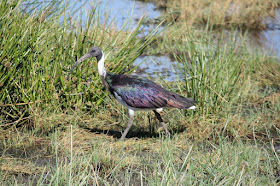
Kakadu covers an area of 20,000 very diverse square kilometres. Rainforests, wetlands, tidal flats, plunging waterfalls, huge tidal rivers, and massive vertical cliffs are all part of the magic of Kakadu.

Billabongs and wetlands at this time of year are full of bird life, water lilies and crocodiles. One morning we went on a boat tour to the Yellow Water Wetlands where we saw about ten crocodiles cruising the waterways for their favourite food, barramundi.
The Aboriginal culture here at Kakadu is very strong and many of the tours are with Aboriginal guides. Some of the rock art is dated at over 20,000 years old, is incredibly well preserved and very detailed. We climbed Ubirr rock, where much of this art work is painted.. From here you can see the huge escarpments in the distance which border Arnhem Land.

While staying in the National Park there is always something to do and see. Our car has been on many four wheel drive tracks while here and once again for Mike’s enjoyment, lots of water crossings. Our deepest one this time was 60cm which had me very nervous.

The weather has been hot every day between 30 and 35 degrees so we get our walks in early. Most of the walks into the gorges, waterfalls and swimming holes are
 only about 2 kilometres but clambering over huge boulders in the heat can really zap your energy. The camp grounds we stayed at had resort style swimming pools so we spent the afternoons lazing around them.
only about 2 kilometres but clambering over huge boulders in the heat can really zap your energy. The camp grounds we stayed at had resort style swimming pools so we spent the afternoons lazing around them.The two Uranium mines, Ranger and Jabiluka are located near the main township of Jabiru. We drove out to the Ranger mine one day and typical of all mines has huge trucks, piles of slag, and a deep hole. The only thing that we didn’t see is how they take the uranium out of here. There are no train lines so it must be moved by truck. Beside the mine is a beautiful billabong where we saw our first close up of a Jabiru. It is interesting that with all the ugliness of the mine, beauty is right next door.
























